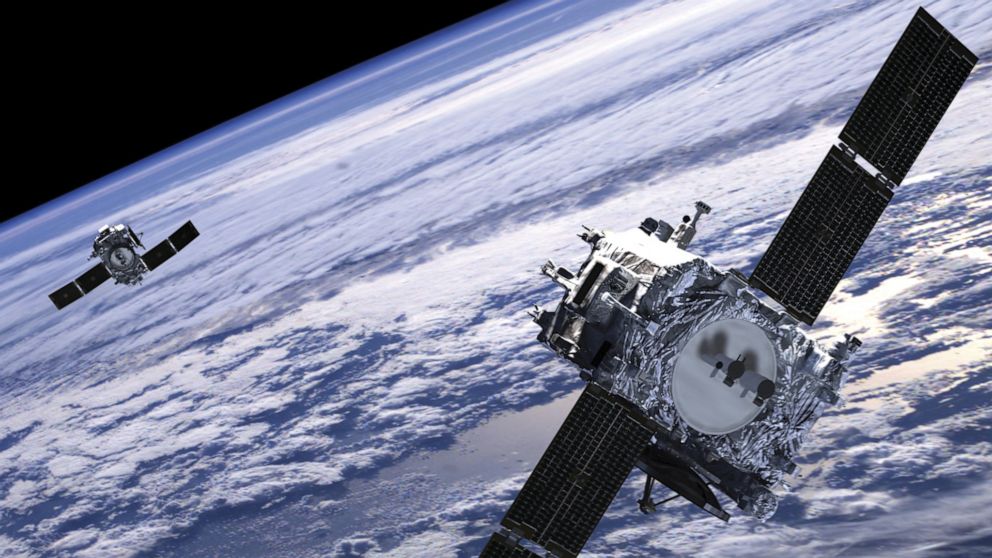美国太空司令部指控俄罗斯上周在太空测试反卫星武器时,一颗在轨道上运行的俄罗斯军事卫星释放了一个朝另一颗俄罗斯卫星方向的物体。
这标志着俄罗斯三年来第二次测试新技术,这些新技术可能导致所谓的“杀手卫星”
周四发表的一份声明称:“美国太空司令部有证据表明,俄罗斯进行了一次天基反卫星武器的非破坏性试验。”“7月15日,俄罗斯将一个新的物体从宇宙2543号(目前卫星目录号为45915)射入轨道www.space-track.org。"
在另一份声明中,英国航天局局长、空军副元帅哈维·史密斯(Harvey Smyth)表示,“我们对俄罗斯发射一枚具有武器特征的射弹来测试其一颗卫星的方式感到关切。”
Smyth说:“这种行为威胁到空间的和平利用,并有可能造成碎片,对卫星和世界所依赖的空间系统构成威胁。”“我们呼吁俄罗斯避免任何进一步的此类试验。”
上周的试验类似于2017年进行的一次试验,当时一颗俄罗斯卫星“弹射”或“诞生”了一颗较小的子卫星,俄罗斯称其为“检查卫星”,因为它们可以接近其他卫星以“检查”损坏情况。

一位艺术家对地球轨道卫星的构想。
但是,2017年的核试验引起了美国官员的主要担忧,因为接下来会发生什么。俄罗斯侦察卫星靠近一颗美国政府卫星,在跟踪它一段时间后,它发射了一枚快速移动的射弹进入太空。
那次试验引起了人们的担忧,即俄罗斯已经为一颗“杀手卫星”开发了武器技术,该卫星可以瞄准属于美国或其伙伴的卫星。
上周的试验几乎与2017年的事件一模一样,只是这颗子卫星在发射炮弹之前一直在跟踪另一颗俄罗斯军事卫星。
美国太空司令部司令、美国太空部队太空作战部部长约翰·w·杰·雷蒙德(John W . Jay Raymond)将军说:“用于进行这次在轨武器试验的俄罗斯卫星系统,正是我们今年早些时候在俄罗斯靠近一颗美国政府卫星时提出关切的那个卫星系统。”
他周四表示:“这进一步证明,俄罗斯在继续努力开发和测试天基系统,并按照克里姆林宫公布的军事原则,使用威胁美国和盟国太空资产的武器。”
与此同时,俄罗斯国防部在上周的一份声明中表示,测试仅仅涉及一颗侦察卫星接近另一颗俄罗斯卫星。
雷蒙德并不羞于批评俄罗斯新的太空武器能力。
今年2月,雷蒙德首次在一份太空新闻俄罗斯宇宙-2542号卫星于去年11月发射,在接受采访时,该卫星发射了一颗卫星,宇宙-2543号,与上周试验中发射的是同一颗卫星。
他说,两颗卫星都在美国政府卫星附近“积极机动”,太空观察家认为这是美国先进的间谍卫星美国-245。
今年4月,雷蒙德提供了那次遭遇的更多细节,称两颗俄罗斯卫星在跟踪美国卫星时进行的演习“将被解释为不负责任,并可能在任何其他领域构成威胁。”
雷蒙德的评论包含在一个太空司令部新闻稿批评俄罗斯测试一种能够摧毁低地球轨道卫星的直接上升反卫星导弹。
具有讽刺意味的是,周四早些时候,在唐纳德·特朗普总统和俄罗斯总统弗拉基米尔·普京通电话时,两位领导人都讨论了美俄空间合作的一个亮点,即美国和俄罗斯签署《21世纪议程》45周年阿波罗-联盟号航天任务。
Pentagon calls out Russia for testing anti-satellite weapon
U.S. Space Commandhas accusedRussiaof testing an anti-satellite weapon in space last week, when an orbiting Russian military satellite released an object that headed in the direction of another Russian satellite.
This marks the second time in three years that Russia has tested new technologies that could lead to so-called "killer satellites."
"U.S. Space Command has evidence that Russia conducted a non-destructive test of a space-based anti-satellite weapon," according to a statement issued Thursday. "On 15 July, Russia injected a new object into orbit from Cosmos 2543, currently Satellite Catalog Number 45915 inwww.space-track.org."
In a separate statement, Air Vice-Marshal Harvey Smyth, the head of the UK's space directorate, said, "We are concerned by the manner in which Russia tested one of its satellites by launching a projectile with the characteristics of a weapon."
"Actions of this kind threaten the peaceful use of space and risk causing debris that could pose a threat to satellites and the space systems on which the world depends," said Smyth. "We call on Russia to avoid any further such testing."
Last week's test was similar to one carried out in 2017, when a Russian satellite "ejected" or "birthed" a smaller sub-satellite that Russia have labeled inspector satellites because they can approach other satellites to "inspect" for damage.
But the 2017 test created major concerns among U.S. officials because of what happened next. The Russian inspector satellite moved close to a U.S. government satellite and, after shadowing it for quite some time, it fired a fast-moving projectile that traveled into space.
That test raised concerns that Russia had developed the weapons technology for a "killer satellite" that could target satellites belonging to the United States or its partners.
Last week's test was almost an exact duplicate of the 2017 incident, except that the sub-satellite had been shadowing another Russian military satellite before it fired a projectile.
"The Russian satellite system used to conduct this on-orbit weapons test is the same satellite system that we raised concerns about earlier this year, when Russia maneuvered near a U.S. government satellite," said Gen. John W. "Jay" Raymond, the commander of U.S. Space Command and the chief of space operations for the Space Force.
"This is further evidence of Russia's continuing efforts to develop and test space-based systems, and -- consistent with the Kremlin's published military doctrine -- to employ weapons that hold U.S. and allied space assets at risk," he said on Thursday.
Meanwhile Russia's Defense Ministry said in a statement last week that the test merely involved an inspector satellite approaching another Russian satellite.
Raymond has not been shy in criticizing Russia's new space-weapon capabilities.
In February, Raymond first disclosed in aSpace Newsinterview that Russian satellite Cosmos-2542, launched in November, had ejected a sub-satellite, Cosmos-2543, the same satellite involved in last week's test.
He said both satellites had been "actively maneuvering" near a U.S. government satellite that space watchers identified as USA-245, an advanced American spy satellite.
In April, Raymond provided more details of that encounter saying the maneuvers the two Russian satellites carried out while shadowing the American satellite "would be interpreted as irresponsible and potentially threatening in any other domain.
Raymond's comments were included in aSpace Command press releasethat criticized Russia for testing a direct-ascent, anti-satellite missile capable of destroying satellites in low-earth orbit.
Ironically, earlier on Thursday, during a phone call between President Donald Trump and Russian President Vladimir Putin both leaders discussed a bright spot in U.S.-Russian space cooperation, the 45th anniversary of theApollo-Soyuz space mission.






